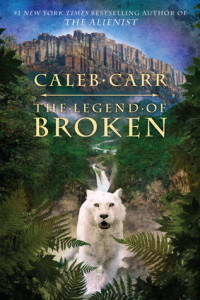Included below is a synopsis of Caleb Carr’s sixth novel, The Legend of Broken, which was published by Random House in 2012. Selected critical reception has also been included. For summaries and selected critical reception of Caleb Carr’s other fiction and non-fiction works, please use the menu.
The Legend of Broken Summary
Publisher’s Blurb
Legend meets history in this mesmerizing novel from #1 New York Times bestselling author Caleb Carr. Demonstrating the rich storytelling, skillful plotting, and depth of research he showcased in The Alienist, Carr has written a wildly imaginative, genre-bending saga that redefines the boundaries of literature.
Some years ago, a remarkable manuscript long rumored to exist was discovered: The Legend of Broken. It tells of a prosperous fortress city where order reigns at the point of a sword—even as scheming factions secretly vie for control of the surrounding kingdom. Meanwhile, outside the city’s granite walls, an industrious tribe of exiles known as the Bane forages for sustenance in the wilds of Davon Wood.
At every turn, the lives of Broken’s defenders and its would-be destroyers intertwine: Sixt Arnem, the widely respected and honorable head of the kingdom’s powerful army, grapples with his conscience and new found responsibilities amid rumors of impending war. Lord Baster-kin, master of the Merchants’ Council, struggles to maintain the magnificence of his kingdom even as he pursues vainglorious dreams of power. And Keera, a gifted female tracker of the Bane tribe, embarks on a perilous journey to save her people, enlisting the aid of the notorious and brilliant philosopher Caliphestros. Together, they hope to exact a ruinous revenge on Broken, ushering in a day of reckoning when the mighty walls will be breached forever in a triumph of science over superstition.
Breathtakingly profound and compulsively readable, Caleb Carr’s long-awaited new book is an action-packed, multicharacter epic of a medieval clash of cultures—in which new gods collide with old, science defies all expectation, and virtue comes in many guises. Brimming with adventure and narrative invention, The Legend of Broken is an exhilarating and enthralling masterwork.
The Legend of Broken Critical Reception
Mr. Carr’s revolution takes place in what is both a historical blank space (the centuries between the fall of Rome and the rise of modern European kingdoms, a period that is still largely opaque) and a haunted landscape: the peak in central Germany known as the “Brockenberg,” which local lore, as well as the authors such as Goethe who drew on it, depicted as home to witches and demons. The advantage of this strategy is that, while we don’t know what was happening there and then, the story can exploit the resonances with what happened later … “The Legend of Broken” adopts two other high-risk strategies. One is to add 80 pages of notes, many feigned to be by Gibbon, others signed “C.C.,” for Caleb Carr. They’re all good fun, and lovingly detailed, but will people read them? The other strategy, now quite a popular one, is to tell the whole story in the present tense. This mode does feel more immediate, but it forces on the reader the sense of being an observer … Pastiche, collage, layered narrative: We ought to be getting used to these effects, and Mr. Carr has used them before, notably in his “The Italian Secretary” (2005), a re-created (and authorized) Sherlock Holmes story. They make demands on the reader, though. The more you put in, the more you get out. Read those notes.
The Washington Post and Austin Statesman:
Set circa 745 A.D., during Europe’s Dark Ages, “The Legend of Broken” straddles the line between epic fantasy and alternate history … an excellent and old-fashioned entertainment that evolves into a clever discourse on the history and development of modern warfare. Best known for novels like “The Alienist” and “The Angel of Darkness,” Carr is also a noted military historian. “The Legend of Broken” has none of the fin-de-siecle trappings that distinguished his earlier novels, but his gift for integrating historical detail with lurid spectacle rivals those on display in the much-missed BBC/HBO series “Rome.” … Carr’s depiction of 8th-century Europe as a gallimaufry of religions, superstitions, science and cultural tradition is marvelous: His Dark Ages contain incandescent flashes of insight into an era that itself is often resigned to a mere footnote … At its best, “The Legend of Broken” seamlessly blends epic adventure with serious research and asks questions that men and women grappled with in the Dark Ages and still do today.
The most appealing single word to describe Caleb Carr’s new epic fantasy novel is probably “scholarly.” That doesn’t approximate everything that the book is, not by a long shot, but at least it gives you something of an idea. Carr helpfully provides an introductory note explaining that The Legend of Broken is a fifth-century manuscript that has been translated into 18th-century English by the esteemed historian Edward Gibbon. This may not sound instantly appealing to your average reader, but as a piece of scholasticism, The Legend of Broken is something of an achievement. It is hard enough for a 21st-century author to sound like a forgotten and legendary fifth-century manuscript or an 18th-century historian; Carr manages to do both at the same time and to sustain the effect for hundreds of pages. The novel is also salted with copious footnotes on linguistic or scientific matters … The Legend of Broken is at its best and most gripping when it is dealing with fearsome tortures, vicious raiders or plague-maddened townspeople. Unlike your average fantasy novelist, Carr does nothing to sugarcoat or downplay the savagery and horror of this time period … As a scholarly work–and there’s that word again–The Legend of Broken is a noble attempt at recasting the high fantasy novel into something more than the pulpy nature of its origins.
Want to Know More?
To learn more, see the following history blogs:

